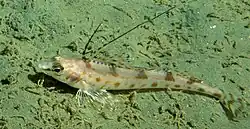Zaniolepis
| Zaniolepis Temporal range: Pleistocene to Present[1]
| |
|---|---|

| |
| Longspine Combfish (Z. latipinnis) | |
| Scientific classification | |
| Kingdom: | Animalia |
| Phylum: | Chordata |
| Class: | Actinopterygii |
| Order: | Perciformes |
| Suborder: | Cottoidei |
| Superfamily: | Jordan & Gilbert, 1883 |
| Family: | Jordan & Gilbert, 1883[2] |
| Genus: | Girard, 1858 |
| Type species | |
| Zaniolepis latipinnis Girard, 1858[3]
| |
| Synonyms[3] | |
| |
Zaniolepis, the combfishes, is a genus of marine ray-finned fish. It is the only member of the family Zaniolepididae, classified within the suborder Cottoidei of the order Perciformes.[4] These fishes are native to the eastern Pacific Ocean.
Taxonomy
Zaniolepis was first proposed as a monospecific genus in 1858 by the French zoologist Charles Frédéric Girard when he described Z. longispinis from Fort Steilacoom on Puget Sound in Washington.[5][6]
Zaniolepididae was first proposed as a family in 1883 by the American ichthyologists David Starr Jordan and Charles Henry Gilbert. this taxon was previously classified as the subfamily Zaniolepinae within the Hexagrammidae.[7] This family is classified within its own superfamily, the Zaniolepidoidea, within the suborder Cottoidei of the Scorpaeniformes.[8] Other workers have found that if the Scorpaeniformes, as delimited in Fishes of the World, is not included in the Perciformes it renders the Perciformes paraphyletic. These workers retain the Cottoidei as a suborder within the Perciformes while reclassifying Zaniolepidoidea as the infraorder Zaniolepidoales.[9] Presently, Eschmeyer's Catalog of Fishes keeps the Zaniolepididae as a family of the Cottoidei in Perciformes.[10]
Previously, the painted greenlings in Oxylebius were also classified in the family Zaniolepididae. However, such a placement is paraphyletic with respect to Hexagrammidae, and so the Catalog of Fishes retains Oxylebius in the Hexagrammidae.[11]
Etymology
Zaniolepis is a combination of xanion, which is a Greek word for a comb used to card wool, and lepis, meaning "scale", referring to the overlapping, almost ctenoid scales of Z. latipinnis.[12]
Species
The currently recognized species in this genus are:[13]
| Image | Scientific name | Common Name | Distribution |
|---|---|---|---|
| Zaniolepis frenata C. H. Eigenmann & R. S. Eigenmann, 1889 | shortspine combfish | Pacific Ocean southern Oregon, USA to central Baja California, Mexico. | |
 |
Zaniolepis latipinnis Girard, 1858 | longspine combfish | northeast Pacific Ocean |
Characteristics
Zaniolepis combfishes have a deep incision in the rear third their dorsal fin and the first 3 spines in the dorsal fin are highly elongated, extremely so in Z. latipinnis. The anal fin contains 3 spines while the first 2 rays in the pelvic fins are long and robust and extend past the origin of the anal fin. The caudal fin truncated.[6] These fishes reach a maximum length of 25 cm (9.8 in).[14]
Distribution and habitat
Zaniolepis combfishes are found in the eastern North Pacific Ocean from Alaska to Baja California. They are benthic fishes.[14]
Utilization
Zaniolepis frenata has been recorded as a source of food for the Native American inhabitants of San Nicolas Island off the coast of Southern California during the Middle Holocene.[15]
References
- ^ Sepkoski, Jack (2002). "A compendium of fossil marine animal genera". Bulletins of American Paleontology. 364: 560. Archived from the original on July 23, 2011. Retrieved 2009-02-27.
- ^ Richard van der Laan; William N. Eschmeyer & Ronald Fricke (2014). "Family-group names of Recent fishes". Zootaxa. 3882 (2): 001–230. doi:10.11646/zootaxa.3882.1.1. PMID 25543675.
- ^ a b Eschmeyer, William N.; Fricke, Ron & van der Laan, Richard (eds.). "Genera in the family Zaniolepididae". Catalog of Fishes. California Academy of Sciences. Retrieved 3 December 2022.
- ^ Fricke, R.; Eschmeyer, W. N.; Van der Laan, R. (2025). "ESCHMEYER'S CATALOG OF FISHES: CLASSIFICATION". California Academy of Sciences. Retrieved 2025-02-10.
- ^ Eschmeyer, William N.; Fricke, Ron & van der Laan, Richard (eds.). "Species in the genus Zaniolepis". Catalog of Fishes. California Academy of Sciences. Retrieved 3 December 2022.
- ^ a b J. S. Nelson; T. C. Grande; M. V. H. Wilson (2016). Fishes of the World (5th ed.). Wiley. pp. 467–495. ISBN 978-1-118-34233-6.
- ^ Catherine W. Mecklenburg & William N. Eschmeyer (2003). "Family Hexagrammidae Gill 1889 Greenlings" (PDF). California Academy of Sciences Annotated Checklists of Fishes. 2.
- ^ J. S. Nelson; T. C. Grande; M. V. H. Wilson (2016). Fishes of the World (5th ed.). Wiley. pp. 467–495. ISBN 978-1-118-34233-6.
- ^ Ricardo Betancur-R; Edward O. Wiley; Gloria Arratia; et al. (2017). "Phylogenetic classification of bony fishes". BMC Evolutionary Biology. 17 (162): 162. Bibcode:2017BMCEE..17..162B. doi:10.1186/s12862-017-0958-3. PMC 5501477. PMID 28683774.
- ^ Fricke, R.; Eschmeyer, W. N.; Van der Laan, R. (2025). "ESCHMEYER'S CATALOG OF FISHES: CLASSIFICATION". California Academy of Sciences. Retrieved 2025-02-10.
- ^ Fricke, R.; Eschmeyer, W. N.; Van der Laan, R. (2025). "ESCHMEYER'S CATALOG OF FISHES: CLASSIFICATION". California Academy of Sciences. Retrieved 2025-02-10.
- ^ Christopher Scharpf & Kenneth J. Lazara, eds. (11 July 2021). "Order Perciformes: Suborder Cottoidea: Infraorder Zaniolepidoales: Family Zaniolepidae". The ETYFish Project Fish Name Etymology Database. Christopher Scharpf and Kenneth J. Lazara. Retrieved 3 December 2022.
- ^ Eschmeyer, William N.; Fricke, Ron & van der Laan, Richard (eds.). "Genera in the family Zaniolepididae". Catalog of Fishes. California Academy of Sciences. Retrieved August 7, 2025.
- ^ a b Froese, Rainer; Pauly, Daniel (eds.). "Species in genus Zaniolepis". FishBase. August 2022 version.
- ^ Vellanoweth, R. L. & Erlandson, J. M. (1999). "Middle Holocene Fishing and Maritime Adaptations at CA-SNI-161, San Nicolas Island, California" (PDF). Journal of California and Great Basin Anthropology. 21 (2): 257–274.